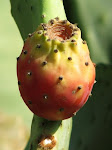The central bus station of Tel Aviv , considered the biggest or the second biggest passenger bus terminal in the world, is a huge complex dominating the southern part of the city. It has seven floors (three out of them used as bus terminals), entrances, bridges, excalators, elevators, shops, eating places. (I share the view of many people, that architecturally, this central station is badly designed and difficult to navigate).
exterior of the central bus station- partial view
The neigborhoods surrounding the central bus station are relatively crowded and poor. Here is where thousands (it started as hundreds, some four years ago) of africans from Sudan, Eritrea, Nigeria and other african countries find refuge. They come through Egypt, travel along the Sinai desert and illegally cross the border entering Israel - tempted by the freedom and economic possibilities here.
Once in Israel, they call themselves 'asylum-seekers' and 'refugees' who have escaped persecution in their native countries. The local population , on the other hand, sees them as 'foreign workers', 'illegal immigrants', 'infiltrators'.
There's much tension in the air, and lately there have been serious demonstrations in the above mentioned neighborhoods; residents in these neighborhoods, alarmed by the increasing numbers of migrants and the social problems created by their presence, demanded the expelling of the later back to their continent or at least to the neighborhoods of those who employ them.
There's much tension in the air, and lately there have been serious demonstrations in the above mentioned neighborhoods; residents in these neighborhoods, alarmed by the increasing numbers of migrants and the social problems created by their presence, demanded the expelling of the later back to their continent or at least to the neighborhoods of those who employ them.
Anyhow, there are humanitarian organizations that help these foreigners in many ways. On one of the floors of the central bus station, for instance, there's a medical clinic offering them health services. They can also get legal advice given by volunteer lawyers.
waiting at the medical clinic for refugees
It's one thing to read about the african "invasion" in the newspapers or watch the phenomenon on TV, and another thing to experience it in reality. I visited the area several times in the last two weeks as I was interested in buying a sewing machine at an importer's shop located on the same street with the central bus station. Well, I felt like I was in an african town. It was a strange feeling, hard for me to define it.
bycicle - popular vehicle among the migrants
.As long as there are shopopkeepers and other business owners or rich families willing to employ the africans - there's little or no chance that they will leave. So, one should better get used to the idea that in the future the city might have an african Mayor.
























































